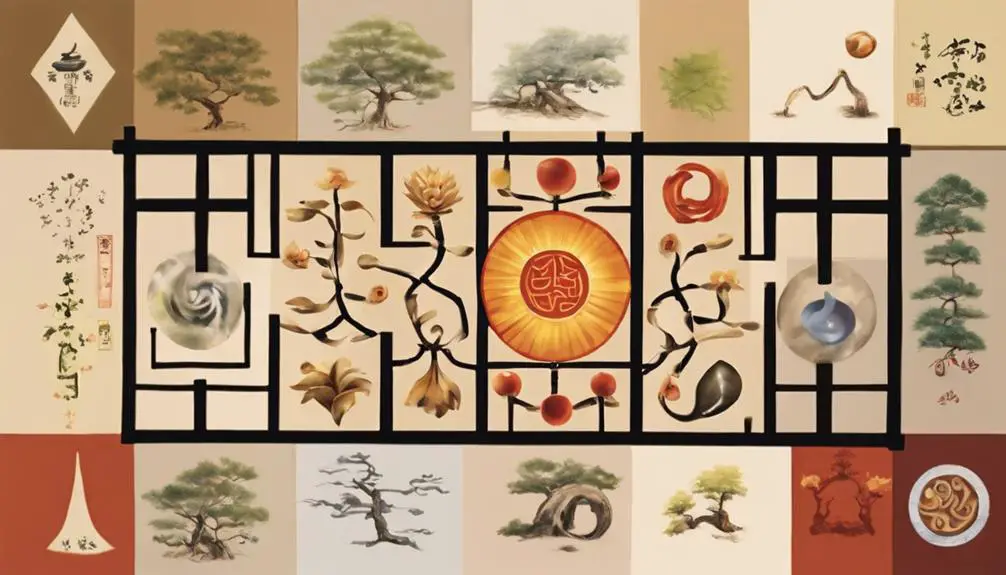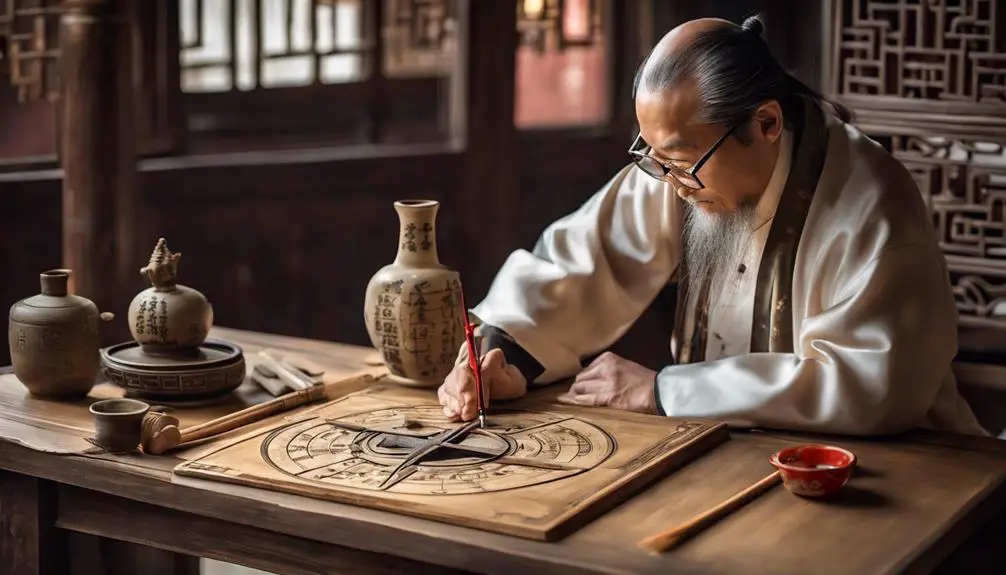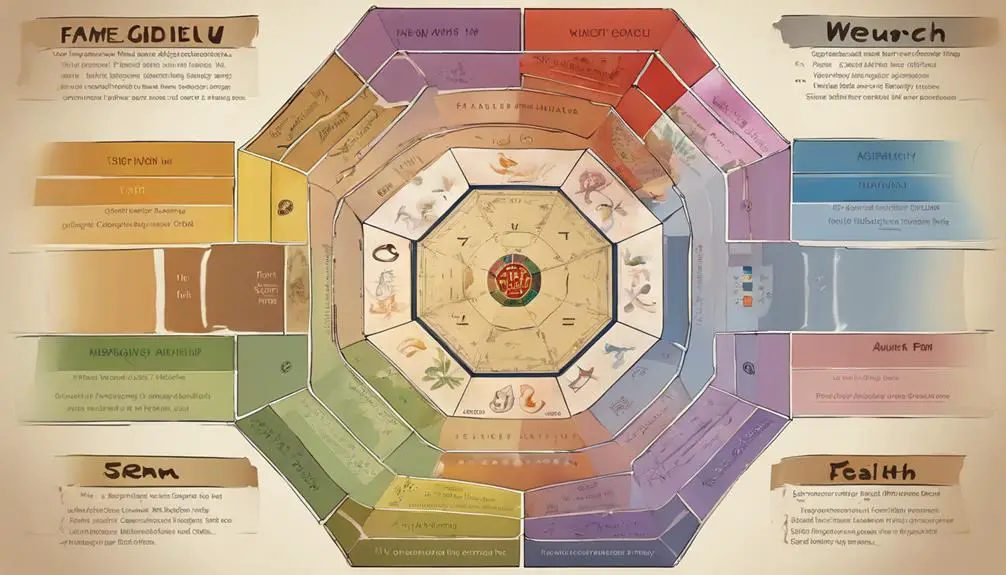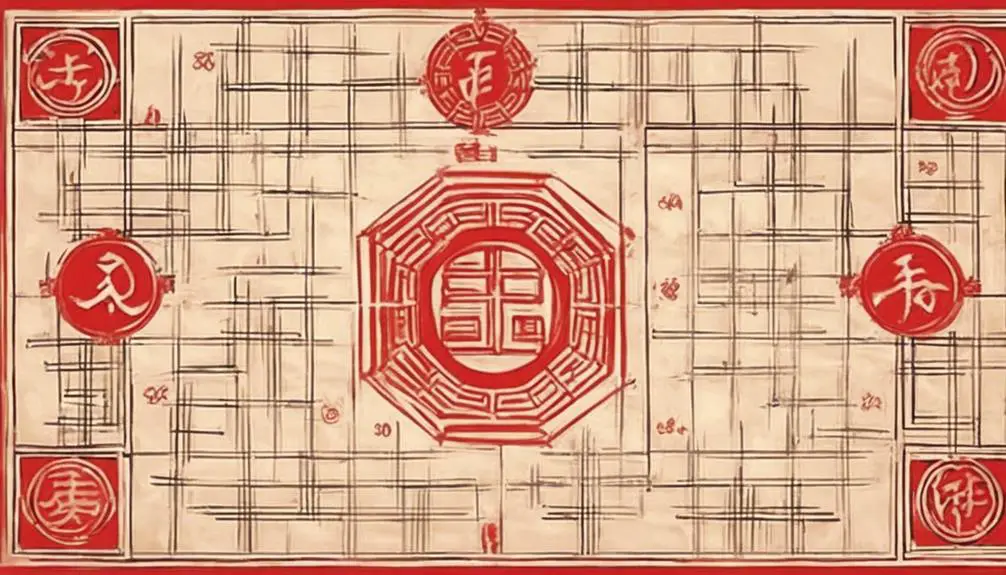Learn how the Feng Shui square can harmonize your home's energy, and discover where to place it for optimal balance and positivity.

Feng Shui Square
Imagine you're an artist, and your home is the canvas, wouldn't you want to create a masterpiece? That's where the Feng Shui square comes in. This ancient Chinese design tool is your brush to harmonize and balance energy within your living space.
And it's not as mystical as it sounds. With a basic understanding of the Feng Shui principles, you can transform your home into a sanctuary of positivity and well-being.
However, there's a catch. Do you know where to place your Feng Shui square for optimal results?
Key Takeaways
- The Feng Shui square is a holistic tool that guides the harmonization of energy in living spaces, enhancing various life aspects.
- Historically, Feng Shui has been integral to Chinese architecture, city planning, and burial rites, and its influence extends to modern global practices.
- The square, symbolizing earth energy and stability, strategically guides the balanced flow of chi or life force, each section corresponding to a specific type of energy.
- Implementing Feng Shui at home involves balancing the five elements using the Bagua map, understanding the square's significance, and creating a harmonious living space.
Understanding the Feng Shui Square

To truly get to grips with the concept of the Feng Shui square, you'll need to delve into the ancient philosophy's principles, analyzing how each element contributes to achieving balance and harmony in a given space. This square, often referred to as the Lo Shu Square or magic square, has profound square symbolism, deeply rooted in cultural influences.
You'll notice the square is divided into nine equal parts, each representing a specific aspect of life. The number nine here isn't just a random choice. In Chinese culture, it signifies completion and fulfillment, echoing the philosophy's emphasis on harmony.
The arrangement of these squares isn't arbitrary. It's intentionally designed to mirror the natural world, embodying the principles of Yin and Yang. It's a representation of the earth's elements and directions, each having a specific energy or 'chi' that influences our lives.
You can manipulate these energies using Feng Shui tools, like mirrors, plants, or crystals, to enhance certain aspects of your life. For example, if you want to boost your career, you'd concentrate on the north section of your Feng Shui square.
As you can see, understanding the Feng Shui square is more than just aesthetics; it's a holistic approach to achieving balance and harmony.
Historical Significance of Feng Shui

Delving into the rich tapestry of history, you'll find that Feng Shui's significance extends beyond mere home decoration, playing a pivotal role in Chinese architecture, city planning, and even burial rites. Tracing Feng Shui origins back, it's evident that this ancient art was an integral part of Chinese culture for over 3,000 years.
Feng Shui was originally used to find safe, auspicious sites for buildings and graves. You'd see it implemented in city planning, where the placement of buildings was meticulously decided according to the principles of Feng Shui. It wasn't just about aesthetics – it was about creating harmony between humans and their environment, a concept deeply rooted in Taoist ideology.
Focusing on cultural influence, Feng Shui's principles permeated many aspects of Chinese life. From the arrangement of furniture in homes to the layout of imperial palaces, it was everywhere. Even today, you'll see its impact in modern architecture and urban planning, not only in China but globally.
In essence, Feng Shui's historical significance is profound. It's not merely a decorating style, but a testament to the intricate relationship between man and his environment.
Principles of the Feng Shui Square

Building on this historical foundation, let's now explore the principles of the Feng Shui Square, a crucial component of this ancient practice. Square Symbolism in Feng Shui is deeply rooted in the philosophy of harmony and balance. Essentially, the square represents the Earth element, denoting stability, groundedness, and material matters. This geometric figure is used as a tool to divide space into nine equal parts, each corresponding to different life aspects.
Understanding energy flow in the Feng Shui Square is equally vital. It's all about the chi or the life force energy. The layout of the square is designed to guide this energy flow in a smooth, balanced manner. Each section of the square, known as a gua, is associated with a specific type of energy. For instance, the north gua is linked to career and life path energy. This systematic approach ensures that the energy is channeled in a way that enhances positivity and reduces negativity in your environment.
Applying Feng Shui Square at Home

Incorporating the Feng Shui Square in your home isn't merely about aesthetics; it's a strategic move that can significantly enhance the flow of positive energy and bring harmony to your living space.
To start, you'll need to understand the concept of Balancing Elements. In Feng Shui, the five elements – wood, fire, earth, metal, and water – should be balanced throughout your home. Each element represents certain attributes and is associated with a specific color, shape, and area of the Bagua map. For example, wood represents growth and creativity, and is symbolized by green and rectangular shapes.
Next, focus on Bagua Map Placement. This octagonal diagram is central to the Feng Shui Square, guiding the allocation of elements in your home. Each section of the Bagua map corresponds to a different life area, like wealth, health, or relationships. By placing the Bagua map over your home's floor plan, you can identify which areas need more attention and balance the elements accordingly.
Common Feng Shui Square Misconceptions

While you may be eager to apply the principles of the Feng Shui Square in your home, it's crucial to debunk some common misconceptions that could potentially throw off your balance. One pervasive myth is that the square symbolism is merely aesthetic. Contrarily, in Feng Shui, the square represents earth energy and stability, and its strategic placement can greatly impact your space's energy flow.
Misinterpretation impacts your Feng Shui efforts in a significant way. For example, some people wrongly believe that Feng Shui is a quick fix and will instantaneously harmonize their space. However, the accurate application of the Feng Shui square requires time, patience, and thoughtful consideration of your space's unique attributes.
Another common misconception is that all areas within the Feng Shui square hold equal importance. This isn't true. Each section has its unique significance and influences different aspects of your life such as wealth, health, relationships, and career. Understanding and respecting these distinctions are vital to successful Feng Shui practice.
Tips for Successful Feng Shui Implementation

To effectively apply Feng Shui in your space, you'll need to master a few key techniques that can maximize its potential benefits and harmony. One important aspect is understanding the Shui Symbols Significance. Each symbol, such as the dragon, turtle, phoenix, and tiger, represents a different energy and can be used to enhance certain areas of your life. For example, the dragon symbolizes power and good fortune, and placing a dragon symbol in the east of your space can bring prosperity.
Feng Shui Colors are another vital component. Each color corresponds to a different element and can affect the energy and mood of your space. For instance, green represents the wood element, which symbolizes growth and vitality. Therefore, incorporating green in your space can foster a sense of growth and freshness.
The key to successfully implementing Feng Shui is to be intentional and thoughtful about each element you incorporate. Whether it's the placement of furniture, use of symbols, or selection of colors, every decision should be made with the aim of creating balance and harmony in your space. With these tips, you're well on your way to a successful Feng Shui implementation.
Frequently Asked Questions
How Does the Feng Shui Square Relate to Other Elements of Feng Shui Such as the Bagua or Five Elements?"
You're delving into the interconnected world of Feng Shui, where the square symbolism represents earth and stability. It's integral to achieving a harmonic balance in your space.
This balance relates strongly to the Feng Shui Bagua, a tool used to map energy in your surroundings.
The square also aligns with the Five Elements theory, influencing the energy flow.
Comprehending these relationships enhances your Feng Shui practice, creating a nurturing, harmonious environment.
Are There Any Famous Buildings or Structures That Have Been Designed Using the Feng Shui Square?"
Yes, you'll find many famous buildings designed using square symbolism, a key principle in Feng Shui basics.
For instance, the Forbidden City in Beijing was built adhering to these guidelines. The square shape is seen as earthy, grounding and stable in Feng Shui, which is why many ancient Chinese buildings and structures feature it prominently.
This shows the deep-rooted influence of Feng Shui in traditional architecture.
How Does the Feng Shui Square Differ Across Various Cultures or Regions?"
You're looking at how square symbolism varies across cultures, right?
In terms of cultural interpretations, it's not a one-size-fits-all. While it's predominantly used in Chinese architecture, its meaning can shift from culture to culture.
In some cultures, it's regarded as a symbol of stability and Earth, while in others, it might signify a form of divine order. It's fascinating to see how this simple shape carries such varied significance.
Can the Feng Shui Square Be Effectively Applied to Non-Residential Spaces, Like Offices or Commercial Buildings?"
Absolutely, you can apply the square's significance to non-residential spaces like offices or commercial buildings. It's all about harmonizing energy. By properly aligning furniture, lighting, and decor, you'll promote productivity and positivity.
However, each space is unique, so you can't apply a one-size-fits-all approach. You must consider the building's layout, purpose, and occupants. So yes, with careful thought and implementation, you can effectively apply these principles to any environment.
What Are Some of the Challenges or Obstacles One May Face When Trying to Integrate the Feng Shui Square in a Modern Design Layout?"
When integrating traditional concepts into modern design, you'll face several challenges. Square limitations may inhibit the flexibility required by contemporary layouts, posing a significant obstacle.
Adapting old principles to new aesthetics isn't always straightforward. You've to balance functionality with honoring the original intent of the square. Remember, it's not about forcing a square into a circle, but finding a way to make them complement each other. It's a tough, but achievable task.
Conclusion
So, you've explored the history and principles of the Feng Shui square, learned how to apply it at home, debunked some common misconceptions, and even picked up some handy tips for successful implementation.
Remember, it's all about creating balance and harmony in your living space. Stay persistent and don't be afraid to experiment with different arrangements. Soon enough, you'll begin to feel the positive energy flowing in your home.
Happy Feng Shui-ing!



Sign up